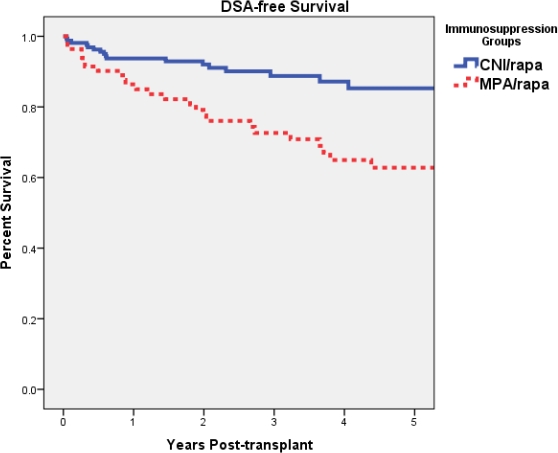Calcineurin (CNI) Exposure Reduces the Risk of Post-Transplant DSA After Deceased Donor Kidney Transplantation
General Surgery, The Ohio State University, Columbus, OH.
Meeting: 2015 American Transplant Congress
Abstract number: D58
Keywords: Alloantibodies, Immunosuppression, Kidney transplantation, Outcome
Session Information
Session Name: Poster Session D: Donor Specific Antibodies/Antibody Mediated Rejection
Session Type: Poster Session
Date: Tuesday, May 5, 2015
Session Time: 5:30pm-6:30pm
 Presentation Time: 5:30pm-6:30pm
Presentation Time: 5:30pm-6:30pm
Location: Exhibit Hall E
We use ATG induction with immediate rapamune (Rapa) and delayed CNI immunosuppression following kidney transplantation. Mycophenolic acid (MPA) is substituted for CNI to avoid renal toxicity when renal function recovery is slow or for CNI intolerance. This study compares the risk of DSA development.
From 1/1/2006 to 10/8/2013 521 DD primary kidney txs were performed in non-sensitized recipients. Of these, 175 were maintained on a CNI/rapa combination and 102 were maintained on a MPA/rapa combination for the entire first post-transplant year. CNI was Neoral and monitored using C2 levels targeted for 800-1000 ng/ml months 1-3, 600-800 ng/ml months 3-6, 400-600 ng/ml months 6-12, 400 ng/ml greater than 12 months. Rapa target level was 10 mg/ml. We compared the post-transplant acute rejection (AR), DSA development, and survival outcomes of these 2 patients groups.
The 2 groups were similar in recipient age, race, and degree of DR and total HLA mismatch. The CNI/rapa group had more females (38.3% vs 25.5%, p=0.03). Follow-up time was longer in the MPA/rapa group (5.3±2.2 vs 3.7±2.0 years, p<0.001). Serum rapa levels were similar at 1, 3, 6, and 12 months post-transplant. The MDRD GFR was significantly lower in the MPA/rapa group at 1 month (47.2±15.4 vs 39.4±19.6, p<0.001) and significantly higher at 12 months (45.6±17.6 vs 50.9±18.6, p=0.025). Death occurred more frequently in the MPA/rapa group (19.6% (20/102) vs 8.0%, 14/175)). Graft loss was similar between groups (3.4% vs 7.8% for CNI/rapa and MPA/rapa groups respectively, p=0.106). The MPA/rapa group experienced more AR in the first year (10.8% vs 2.9%, p=0.006) and at last follow-up (14.7% vs 5.7%, p=0.01). DSA developed in 11% (n=18) of 164 tested CNI/rapa recipients and in 31% (n=26) of 84 tested MPA/rapa recipients (p<0.001). The DSA free Kaplan-Meier survival curves were significantly different by log rank test (p=0.001).

Non-sensitized recipients of primary DD kidney transplants treated with MPA/rapa in the first post-transplant year experienced more AR and DSA development. Maintenance immunosuppression that includes a CNI minimizes the risk of DSA development post-transplant.
To cite this abstract in AMA style:
Pelletier R, Rajab A, Bumgardner G, Henry M. Calcineurin (CNI) Exposure Reduces the Risk of Post-Transplant DSA After Deceased Donor Kidney Transplantation [abstract]. Am J Transplant. 2015; 15 (suppl 3). https://atcmeetingabstracts.com/abstract/calcineurin-cni-exposure-reduces-the-risk-of-post-transplant-dsa-after-deceased-donor-kidney-transplantation/. Accessed January 5, 2026.« Back to 2015 American Transplant Congress
